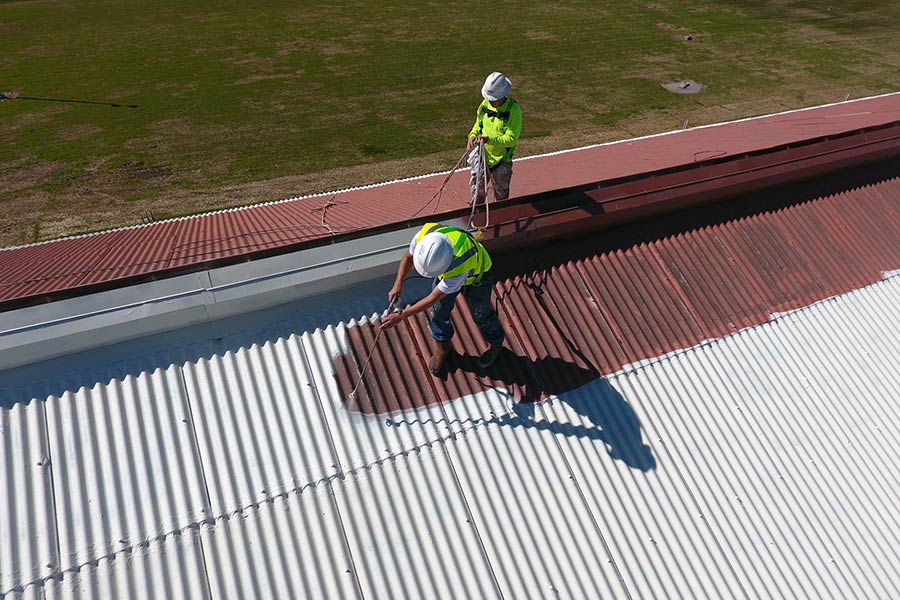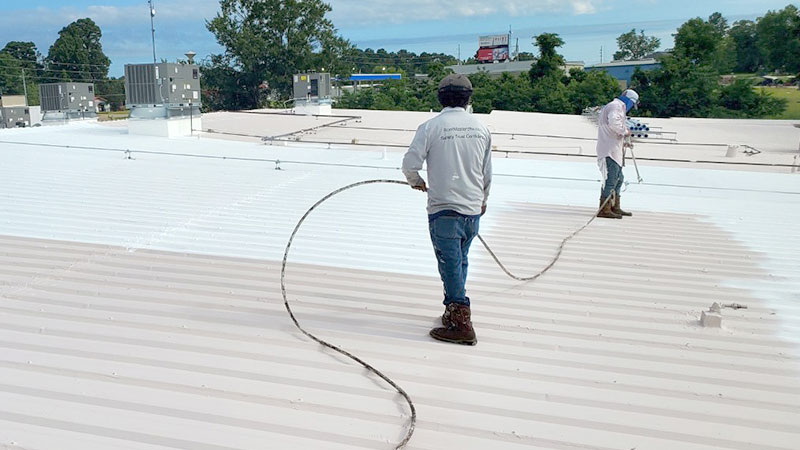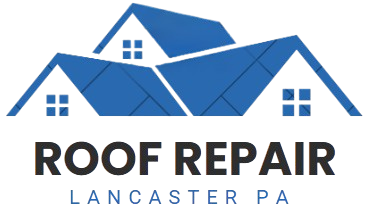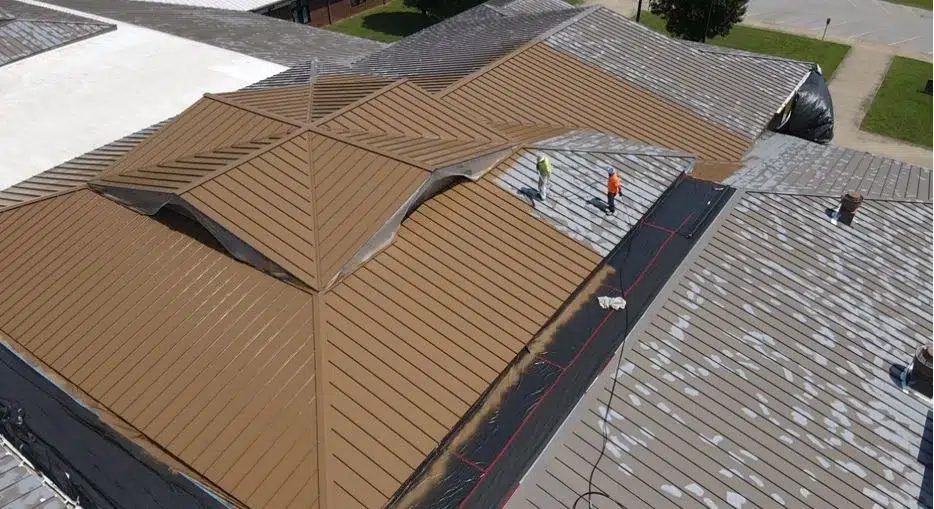When it’s time to protect and extend the life of your roof, the choice of coating makes all the difference. At Roof Repair Lancaster PA, we help homeowners make informed decisions with clear, expert advice. This guide will compare acrylic, silicone, and elastomeric coatings so you can select the very best option for your Lancaster, PA property.
Understanding Roof Coating Types
Acrylic Roof Coatings
- Features: Water-based, high reflectivity, easy application.
- Best for: Sloped metal roofs, some flat roofs.
- Pros:
- Excellent sun (UV) resistance
- Eco-friendly, easy clean-up
- Cost-effective
- Cons:
- Not suited for areas with chronic ponding water
- May require more frequent reapplication in harsh winters

Silicone Roof Coatings
- Features: Solvent-based, excellent waterproofing, resistant to ponding water.
- Best for: Flat or low-slope roofs, roofs with poor drainage.
- Pros:
- Superior water and weather resistance
- Excellent longevity (10–20 years)
- Withstands Lancaster rain and storms
- Cons:
- Higher initial cost
- Can collect dirt, affecting reflectivity over time
Elastomeric Roof Coatings
- Features: Made from various polymers; highly flexible, “rubber-like” performance.
- Best for: Roofs needing flexibility—older, expanding/contracting surfaces.
- Pros:
- Exceptional flexibility
- Can bridge minor cracks and leaks
- Provides additional insulation value
- Cons:
- Performance varies with the chosen base formula
Performance Factors That Matter in Lancaster, PA
When choosing a roof coating, it’s important to consider how each type performs in Lancaster’s unique climate—where heavy rain, snow, sun, and temperature swings are common. The right coating can significantly improve your roof’s durability, efficiency, and resistance to weather damage. For a deeper understanding, check out our guide on how roof coating services can extend the life of your roof.
Weather Resistance
- Acrylic: Great for UV but may degrade with pooling water in humid summers or icy winters.
- Silicone: Handles rain, snow, and temperature swings—built for Lancaster’s varying climate.
- Elastomeric: Excels where temperature fluctuations or roof movement are concerns.
Durability & Longevity
- Acrylic: 5–10 years typical lifespan; may need touch-ups after harsh winters.
- Silicone: 10–20 years; fewer reapplications, even with Lancaster climate stress.
- Elastomeric: 10–20 years, provided high-quality base material is used.
Energy Efficiency & Reflectivity
- Acrylic: Highly reflective (often white), reduces cooling bills.
- Silicone: Good reflectivity; slightly lower than acrylic but good for energy savings.
- Elastomeric: Dependent on base; often rated as “cool roof” when white/pale colors are used.
Benefits for Residential and Commercial Properties
For Residential Properties
- Energy efficiency through high reflectivity (especially acrylic and elastomeric)
- Quick installation minimizes home disruption
- Cost savings compared to full roof replacement
- Moisture protection (silicone, elastomeric) reduces chances of leaks
For Commercial Properties
- Long-term durability (silicone for flat/large roofs reduces maintenance cycles)
- Meets cool roof/energy codes and supports utility savings
- Protects investments—critical for business continuity
- Minimizes downtime with quicker, less invasive application than total replacement
Application & Cost Considerations
| Feature | Acrylic | Silicone | Elastomeric |
| DIY-Friendly | Yes | Requires experience | Depends on base |
| Drying Time | Fast | Moderate | Fast/moderate |
| Initial Cost | $0.75–$1.50/sq.ft. | $1.50–$2.50/sq.ft. | $1.00–$2.00/sq.ft. |
| Maintenance | Moderate | Low | Moderate |
Pricing is general; for a custom estimate, contact Roof Repair Lancaster PA.
Which Roof Coating is Best for Your Lancaster Home?
Here’s how the coatings stack up for Lancaster residents:
| Coating | Best For | Pros | Cons |
| Acrylic | Metal roofs, budget-minded | UV reflection, low cost | Less durable with ponding water |
| Silicone | Flat roofs, heavy rain areas | Long-lasting, waterproof | Attracts dirt, higher cost |
| Elastomeric | Aging roofs, expansion issues | Flexible, crack-bridging | Performance varies by material |
Local Tip: Many Lancaster roofs face rapid temperature swings and severe weather. Silicone is often a top choice for flat roofs; acrylic or elastomeric can excel for sloped or complex surfaces. Call Roof Repair Lancaster PA for a free assessment.
Decision Guide: How to Choose the Right Coating
- Roof Type & Slope: Flat roofs often benefit from silicone; metal or steep roofs may suit acrylic or elastomeric.
- Weather Exposure: For frequent ponding or heavy rain, silicone is king. For intense sun, acrylic’s reflectivity saves energy.
- Budget: Acrylic is cost-friendly; silicone is an investment for longevity.
- Age & Condition: Old, flexible, or repaired roofs can often benefit from elastomeric coatings.
Need expert guidance? Our roof coating services in Lancaster offer detailed inspections and expert recommendations tailored to your roof.

Conclusion
Choosing between acrylic, silicone, and elastomeric roof coatings depends on your roof’s needs, Lancaster’s climate, and your budget. At Roof Repair Lancaster PA, our experts assess every project individually to recommend the best, most cost-effective solution.
FAQs
Can these coatings be used on any roof material?
Most coatings work on metal, single-ply membranes, modified bitumen, and built-up roofs. Always consult a pro before application.
Are these coatings suitable for both flat and sloped roofs?
Yes, though silicone is best for flat roofs, and acrylic for sloped, metal, or less wet areas.
How long does each type of coating last?
Acrylic: 5–10 years.
Silicone & elastomeric: 10–20 years with proper care.
Do these coatings qualify as “cool roofs”?
Yes, especially white or light-colored versions of acrylic and elastomeric. They reduce heat absorption and cut cooling bills.
How often should coatings be reapplied in Lancaster?
Acrylic: every 7–10 years; silicone up to 20 years; elastomeric varies by climate and base material. Regular inspections are key.


Leave a Reply